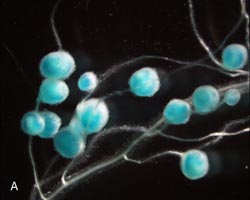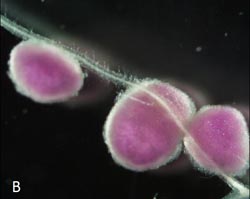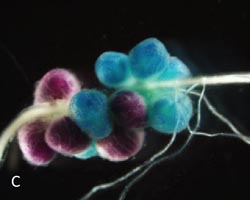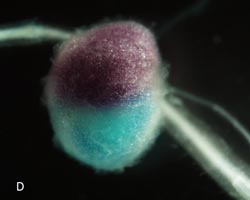Beans nodulate promiscuously with rhizobia. The lack of specificity may be advantageous in certain circumstances but it generally poses a challenge to attempts to successfully inoculate beans. The inoculant strain, when applied, has to compete with indigenous strains for root infection sites and outcomes are dependent on numerous variables. In addition to identifying rhizobia nodulating beans in Kenya and assessing their nitrogen fixing potential (update appeared in Podcaster 25), my research has used a dual marker system to study the competitiveness of indigenous strains against the major commercial inoculant strain, Rhizobium tropici CIAT 899.
R. tropici CIAT 899 was marked chromosomally with gusA gene while Kenyan strains were marked with celB gene borne on a stable broad-host-range plasmid, pGM1. gusA gene on CIAT 899 was either under a constitutive promoter (ptac) or under a symbiotically active promoter (pnifH). The gusA bearing CIAT 899 strains were tested for characteristics such as growth rate and nitrogen fixation and did not differ from the wild type. Similarly, Kenyan strains with pGM1 were not different from parents, symbiotically or phenotypically.




|
Figure 1: (A) Stained nodules after P. vulgaris KK08 was inoculated with CIAT 899 gusA-ptac. (B) Young nodules after inoculation with pGM1 strain. (C) Double stained nodules after inoculation with CIAT 899-gusA (blue) and NAK 104-pGM1 (magenta). (D) Nodule from a double infection event. |
Using the dual marking technique, CIAT 899 was found to out-compete a majority of 38 Kenyan strains for nodulation of P. vulgaris ‘KK08’ in glasshouse co-inoculation experiments (Figure 1A, 1B, 1C). There was no correlation between effectiveness of the strains and their competitiveness. Single and double occupancy events were observed (Figure 1D), with stressful growth conditions seen to promote dual occupancy rates. Experiments looking at impact of different inoculation ratios on competition outcomes are ongoing. Thesis is expected to be submitted for examination by the end of the year.
George Mwenda, Murdoch University, Australia
